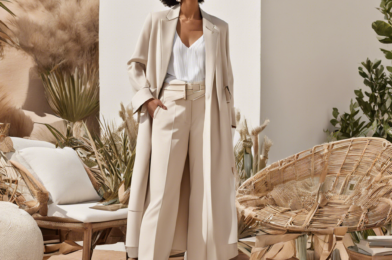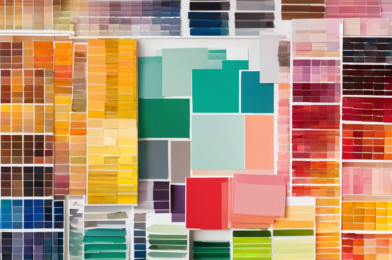Wearing bright colors can be a fun way to express yourself and boost your mood. Color has the power to evoke different emotions and feelings, and when incorporated into your wardrobe, it can make a bold statement or simply add a touch of cheerfulness to your day. If you’re looking to brighten up your style and feel more confident, here are some tips on how to wear bright shades and make a stylish impact.
Start with accessories. If you’re usually more comfortable in neutral clothing, dip your toes into the world of color by starting with accessories. A bright scarf, pair of shoes, or handbag can add a pop of interest to a more subdued outfit. Try a colorful statement necklace or earrings that frame your face and draw attention. Even a simple outfit of jeans and a tee can be elevated with the right accessories, and you’ll soon feel more confident about adding brighter shades to your wardrobe.
Think about color theory. When choosing which colors to wear, consider the color wheel and which shades complement each other. Colors opposite each other on the wheel, like blue and orange or purple and yellow, create a vibrant contrast. Analogous colors, or those that sit next to each other on the wheel, such as yellow and green, also work well together and can create a harmonious and calming effect. Playing with these combinations can lead to some stylish results and is a fun way to experiment with color.
Mix and match. Don’t be afraid to mix and match different colors in your outfits. Layering shades that sit next to each other on the color wheel can create a gradient effect that’s eye-catching yet subtle. Alternatively, try color-blocking by pairing two complementary colors together for a bold statement. For example, team a bright yellow top with violet trousers for an outfit that’s full of energy and life.
Opt for colorful patterns. If wearing bold blocks of color feels like too much, try incorporating colorful patterns into your wardrobe instead. Floral prints, geometric designs, or abstract patterns are a great way to wear multiple colors at once without feeling overwhelmed. Look for patterns that include your favorite shades, or step out of your comfort zone and try something new. You might find that a colorful, patterned dress or blouse becomes your new go-to for an instant mood boost.
Wear colors that flatter your skin tone. Choosing colors that complement your skin tone is an important part of feeling confident in bright shades. If you have a cooler skin tone, shades like emerald green, deep blues, and vibrant pinks will flatter you, while those with warmer skin tones shine in earthy colors like orange, brown, and olive green. Of course, these are just guidelines, and you should ultimately wear whatever colors make you feel happy and confident.
Try a colorful coat. Make a statement by investing in a colorful coat. During the colder months, a bright coat will not only keep you warm but also add a much-needed pop of color to your wardrobe. Whether it’s a vibrant red pea coat or a sunshine yellow raincoat, you’re sure to turn heads and keep your spirits high.
Don’t forget about makeup. Enhance your look by incorporating color into your makeup routine. A sweep of colorful eyeshadow or a bold lip can complement your outfit and really make your features stand out. Try matching your makeup to your outfit, or if you’re feeling daring, contrast a bold lip with a more neutral outfit for a modern and sophisticated take on color.
Keep your clothes well-fitted. When wearing bright colors, it’s important that your clothes fit you well. Ill-fitting garments in bold shades can often look out of place, so tailor them to your body shape for a polished and put-together look. This will ensure you always feel confident and comfortable, whether you’re trying a new color or sticking to old favorites.
Break the rules. Fashion is all about self-expression, so don’t be afraid to break the rules and develop your own unique style. If you love a particular color, go all out and wear it head-to-toe, or mix and match unexpected shades to create a look that’s entirely your own. The most important thing is that you feel comfortable and confident, so have fun and embrace the power of color.
Incorporate bright shades gradually. If you’re new to wearing bright colors, take it slow and incorporate them into your wardrobe gradually. Start with one colorful piece and build from there, perhaps adding a colorful blazer to your usual work ensemble or swapping your everyday black handbag for something in a vibrant shade. Soon enough, you’ll be craving more color in your wardrobe and will feel confident enough to experiment.
Play with textures. Another way to have fun with color is to play with different textures. A bright, silky blouse or a vibrant, fluffy sweater will add depth and interest to your outfit. Don’t be afraid to mix and match textures, either; the contrast of a soft, knit cardigan with a sleek, silk skirt in complementary colors is sure to catch the eye and keep your style looking fresh.
Keep the occasion in mind. While bright colors can be worn for any occasion, it’s important to consider the formality of the event. For more casual events, like brunch with friends or a day at the park, feel free to experiment with fun and playful colors. For formal occasions, like a wedding or work event, opt for richer, more sophisticated shades and elegant silhouettes to ensure you look polished and appropriate.
Repeat colors you love. If you find a color that you love and feel great in, don’t be afraid to buy multiple items in that shade. This will make getting dressed in the morning much easier, as you’ll know that everything already matches. Creating a capsule wardrobe of your favorite shades is a surefire way to boost your mood and make getting dressed something to look forward to.
Keep the rest of your look simple. When wearing bright colors, less is often more when it comes to the rest of your look. Keep your hair, makeup, and accessories simple and streamlined to ensure the focus remains on your fabulous outfit. A sleek, low-maintenance hairstyle and minimal jewelry will ensure that your colorful ensemble takes center stage.
Be confident. Most importantly, wear bright colors with confidence. Own your look and feel proud of stepping out in something that makes you happy. Confidence is the key to pulling off any style, and people will take note of your positive energy and attitude. So, stand tall, wear that bright shade with a smile, and enjoy the mood-boosting power of color.
Adding bright shades to your wardrobe is a surefire way to boost your mood and inject some fun into your style. By incorporating colorful accessories, playing with textures and patterns, and experimenting with color theory, you can create looks that are both stylish and uplifting. So, go ahead and embrace the rainbow – your wardrobe (and mood) will thank you for it!



